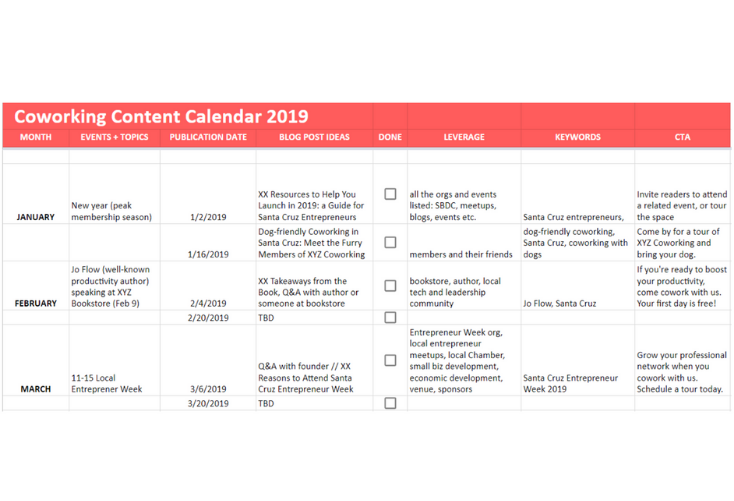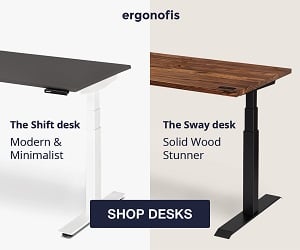- Content marketing is a powerful and inexpensive tool that can help flexible workspace operators get in front of their target audience.
- Creating a content marketing strategy takes time and effort; a content calendar can help operators stay on track with their content strategy.
- A content calendar makes it easier to leverage events and special occasions to gain momentum and generate buzz when publishing content.
Cat Johnson’s training session on How to Create a Content Calendar (and Why You Should) is back by popular demand this July 24th. Register here!
Earlier this week we learned why content marketing should be a priority for coworking operators, where content expert Cat Johnson explained that content marketing is a powerful and inexpensive tool that can help flexible workspace operators get in front of their target audience.
Flexible workspace operators look to content marketing as a way to drive membership levels, create name recognition, strengthen community, raise awareness, market events, engage members, and differentiate themselves from the competition.
This week, Cat hosted a live training session in which she explained how operators can create a content calendar and why they should.
“If you don’t plan it, it doesn’t happen”
A content calendar helps operators extend the reach of their marketing efforts. It keeps you (or your marketing team) accountable and it also helps you plan ahead of time to be able to leverage special occasions and to make sure you are not being repetitive with the content you regularly post.
“Think of a content calendar as your roadmap”, Cat told attendees. It’s a great resource to get you thinking strategically about the messages you are trying to convey. Keep in mind that a content calendar is not set in stone; “if you miss a post or two and fall on the wayside, it’s okay. You’d be surprised at how often that happens to me, publications, and even companies with large marketing budgets.”
To prevent this from happening, however, Cat recommends people regularly check up on their calendar and that they set realistic goals of how often they will post.
Other than being realistic with goals, Cat strongly emphasized that people should play to their strengths. Content can be a blog post, a case study, a podcast, a social media story, or a video. Whichever you choose, make sure it’s something you are comfortable with and that you can handle. “Don’t force yourself into doing video if you’re not experienced with it and don’t have the required tools and resources. Start with what you have and grow from there.”
Regardless of the method you pick, you have to make sure that you are creating intentional content. You have to be strategic or you’ll find yourself wasting a lot of valuable time.
“If you throw things at random, you won’t get the results you are looking for.” Think of different topics you want to address that will be of interest to your readers. “Don’t try to get it right and perfect from the start. You won’t. Your first posts might not work, but they will help in pinpointing what works for your audience and what doesn’t.”

Leveraging events, seasons, and other happenings
Cat explains that when she talks about ‘leverage’ she means using something to its maximum advantage. “Leveraging certain events and happenings lets you get in front of new audiences.”
Things that operators can leverage to create content include:
- Workspace events
- Promotions
- Seasons or special occasions (International Coworking Day, Startup Week, a local event)
- Your people
- Social projects
- Hashtags
Leveraging content like this will help you gain momentum, generate buzz, and expand your content’s reach.
Once you have various ideas on topics and themes, it’s time to decide on “anchor posts” for each month and start creating. If other events or ideas strike randomly, you can add them to the calendar and jump on more occasions as they come up. The important thing is to have at least one topic per month.
“Creating content isn’t effortless. It takes time and resources, but the important thing is that you start doing it. You start creating and you course-correct: you see what falls flat and let go of that, you see what works and strengthen it.”
Sharing original content gives people a reason to keep coming back to your site, but you have to be careful to balance out the kind of posts that you publish.
Cat shares the following type of content that flexible workspace operators can post on their blogs:
- How to’s
- Storytelling posts
- Member profiles
- News or current events
- Wellness focused posts
- Productivity tips
- Resource roundup
- Posts that reflect your brand value
- A Q&A with someone who has an impact in your local market/community
Pro tip: Always include a call to action in your posts. A call to action can be scheduling a tour, booking a free coworking day, subscribing to your newsletter, or liking your social media pages.
Cat’s next live training session on February 6th will focus on creating better member profiles. Reserve your space here.


 Dr. Gleb Tsipursky – The Office Whisperer
Dr. Gleb Tsipursky – The Office Whisperer Nirit Cohen – WorkFutures
Nirit Cohen – WorkFutures Angela Howard – Culture Expert
Angela Howard – Culture Expert Drew Jones – Design & Innovation
Drew Jones – Design & Innovation Jonathan Price – CRE & Flex Expert
Jonathan Price – CRE & Flex Expert













